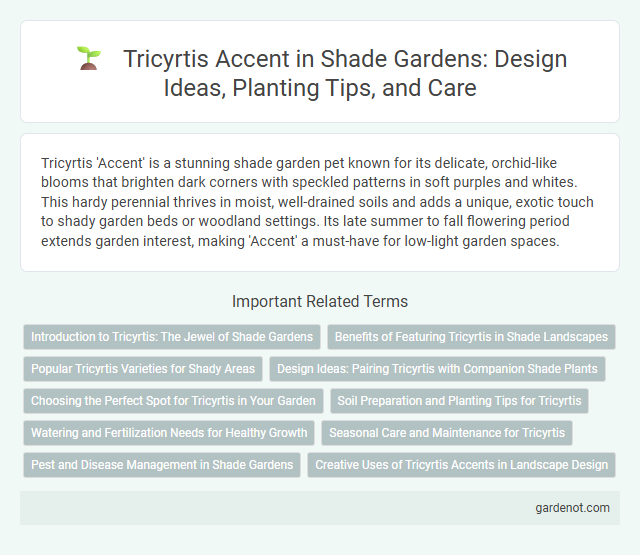Tricyrtis 'Accent' is a stunning shade garden pet known for its delicate, orchid-like blooms that brighten dark corners with speckled patterns in soft purples and whites. This hardy perennial thrives in moist, well-drained soils and adds a unique, exotic touch to shady garden beds or woodland settings. Its late summer to fall flowering period extends garden interest, making 'Accent' a must-have for low-light garden spaces.
Introduction to Tricyrtis: The Jewel of Shade Gardens
Tricyrtis, commonly known as toad lily, thrives in shaded garden areas, offering exquisite, orchid-like flowers that bloom in late summer to fall. This perennial plant is prized for its unique spotted petals and ability to add vibrant color to low-light environments. Ideal for woodland gardens, Tricyrtis accents create focal points among ferns and hostas, enhancing the tranquility and aesthetic appeal of shade gardens.
Benefits of Featuring Tricyrtis in Shade Landscapes
Tricyrtis accent adds striking visual interest to shade gardens with its unique, orchid-like flowers that bloom late in the season, extending garden appeal into autumn. This shade-tolerant perennial thrives in moist, well-drained soils and supports pollinators like bees and butterflies, enhancing biodiversity. Its low maintenance requirements and natural resistance to deer make Tricyrtis an excellent choice for sustainable and attractive shaded landscapes.
Popular Tricyrtis Varieties for Shady Areas
Tricyrtis, commonly known as toad lilies, thrive in shady garden spots with moist, well-drained soil and dappled sunlight. Popular varieties like Tricyrtis hirta, with its spotted lavender flowers, and Tricyrtis formosana, known for larger blooms and vigorous growth, are ideal for adding color and texture to shade gardens. These shade-loving perennials attract pollinators and provide late-season interest with their unique, orchid-like blossoms.
Design Ideas: Pairing Tricyrtis with Companion Shade Plants
Pair Tricyrtis with hostas and ferns to create a lush, textured shade garden that highlights its delicate, orchid-like blooms. Incorporate astilbes and heucheras for contrasting foliage colors and shapes that enhance the Tricyrtis's speckled petals. Use a layered planting design with varying heights and bloom times to maintain year-round interest in shaded garden beds.
Choosing the Perfect Spot for Tricyrtis in Your Garden
Tricyrtis thrives best in shaded or partially shaded garden areas with well-drained, humus-rich soil that mimics its native woodland environment. Selecting a spot with consistent moisture and protection from harsh afternoon sun ensures vibrant blooms and healthy foliage. Positioning Tricyrtis near shade-tolerant companions like ferns or hostas enhances its natural aesthetic and promotes a harmonious garden microclimate.
Soil Preparation and Planting Tips for Tricyrtis
Tricyrtis thrives in well-drained, humus-rich soil with a slightly acidic to neutral pH of 6.0-7.0, making organic matter incorporation essential for soil preparation. Plant Tricyrtis rhizomes in early spring or fall, spacing them 12 to 18 inches apart in shaded to partial shade areas to ensure adequate air circulation and prevent fungal issues. Water thoroughly after planting and mulch with leaf mold or bark to retain moisture and regulate soil temperature.
Watering and Fertilization Needs for Healthy Growth
Tricyrtis, commonly known as toad lily, thrives in consistently moist, well-drained soil, requiring regular watering to prevent drying out, especially during dry spells. Fertilize lightly in early spring with a balanced, slow-release fertilizer to promote healthy growth and vibrant blooms throughout the growing season. Avoid over-fertilization, which can lead to excessive foliage at the expense of flowers.
Seasonal Care and Maintenance for Tricyrtis
Tricyrtis, commonly known as toad lily, thrives in well-drained, humus-rich soil with consistent moisture throughout the growing season. Seasonal care involves protecting the plant from harsh winter conditions by applying a mulch layer to insulate the roots and cutting back dead stems in late fall to promote healthy new growth. Regular monitoring for slugs and fungal diseases ensures optimal plant health in shaded garden environments.
Pest and Disease Management in Shade Gardens
Tricyrtis, commonly known as toad lily, thrives in shade gardens but is susceptible to slugs and aphids that can damage foliage and flowers. Effective pest management includes regular monitoring and the use of organic slug baits or insecticidal soaps to keep populations under control. Disease issues such as leaf spot and powdery mildew can be minimized by ensuring good air circulation and avoiding overhead watering in dense shade environments.
Creative Uses of Tricyrtis Accents in Landscape Design
Tricyrtis accents enhance shade gardens with their unique orchid-like blooms and intricate spotted patterns, creating focal points in low-light areas. Their vertical growth habit and striking flower shapes provide texture contrast and seasonal interest when paired with ferns and hostas. Utilizing Tricyrtis in shaded borders or container arrangements maximizes stunning visual appeal and biodiversity in garden design.
Tricyrtis accent Infographic

 gardenot.com
gardenot.com